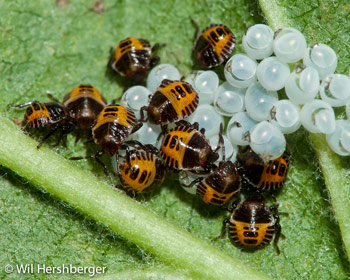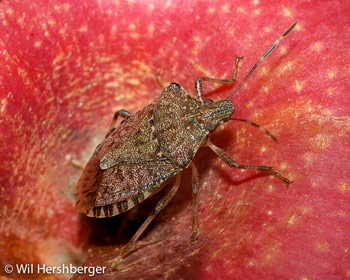Life Stages
Brown marmorated stink bug (BMSB) overwinters as adults in a protective sleeplike state, emerges in the spring, and begins mating in about two weeks. BMSB commonly mates multiple times, and the female may deposit as many as 486 eggs in a lifetime.[1] Development from egg to adult requires approximately 538 degree days, a measure of temperature and time for insect growth,[2] with an additional 148 degree day period before eggs are laid.[3] Its light-green eggs are often laid on the underside of leaves, deposited in masses of approximately 28 eggs.[4]
 |
| From left to right, four nymphal stages of BMSB (second through fifth instar), adult male, and adult female. Photo by W. Hershberger |
 |
| BMSB nymphs, first instar, cluster around a mass of newly-hatched eggs on the underside of a leaf. Photo by W. Hershberger |
 |
| Adult BMSB on an apple. Photo by W. Hershberger |
While the adults blend in with tree bark, the nymphs are more brightly colored. BMSB has five nymphal stages ranging from 2.4 mm to 12 mm in length. Early-stage nymphs do not venture very far from the newly hatched egg mass. The legs and antennae of nymphs are black with white banding.[5] Early-stage nymphs have dark reddish eyes and a yellow-reddish underbelly with black stripes.
BMSB may be able to produce several broods in a single year, thus increasing the potential and duration of risk for crop damage.[6][7] Our research team is seeking to understand the unusual overwintering behavior of the stink bug, as it is believed to move readily among woodlands, buildings, and farmland.[8]
[1] H. Kawada and C. Kitamura, 1983, “The reproductive behavior of the brown marmorated stink bug, Halyomorpha mista Uhler (Heteroptera: Pentatomidae). I. Observation of mating behavior and multiple copulation.” Applied Entomology and Zoology 18: 234-242, via Tracy Leskey et al, 2011, “Biology, ecology, and management of brown marmorated stink bug in orchard crops, small fruit, grapes, vegetables, and ornamentals: USDA-NIFA SCRI coordinated agricultural project.” USDA-ARS Appalachian Fruit Research Station. For more information about the SCRI project proposal, contact project director Tracy Leskey.
[2] University of California at Davis IPM Online provides an excellent introduction to the degree day concept.
[3] A.L. Nielsen, G.C. Hamilton and D. Matadha, 2008, “Developmental rate estimation and life table analysis for Halyomorpha halys (Hemiptera: Pentatomidae).” Environmental Entomology 37: 348-355 via Leskey et al. 2011.
[4] Ibid.
[5] “How to Identify Brown Marmorated Stink Bug.” Rutgers New Jersey Agricultural Experiment Station, accessed April 24, 2012.
[6] K. Kiritani, 2006, “Predicting impacts of global warming on population dynamics and distribution of arthropods in Japan.” Population Ecology 48: 5-12 via Leskey et al. 2011.
[7] K. Kiritani, 2007, “The impact of global warming and land-use change on the pest status of rice and fruit bugs (Heteroptera) in Japan.” Global Change Biology 13: 1586-1595 via Leskey et al. 2011.
[8] Leskey et al. 2011.
